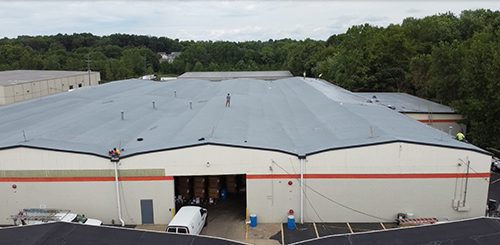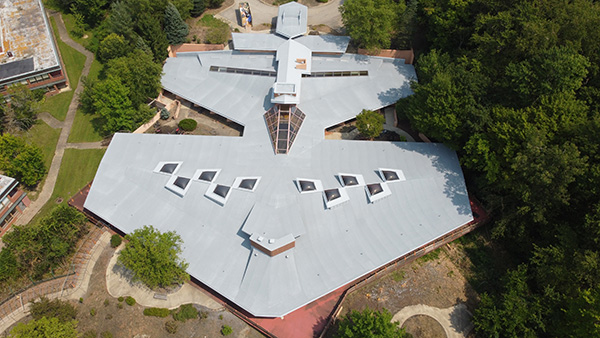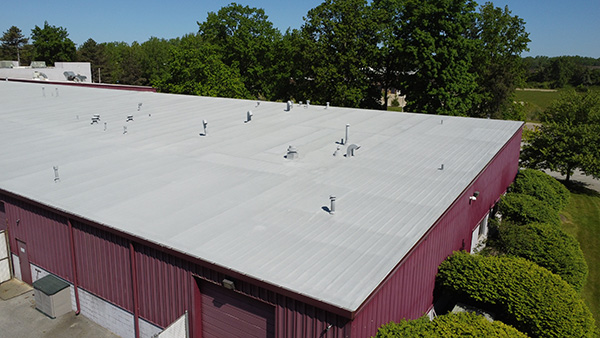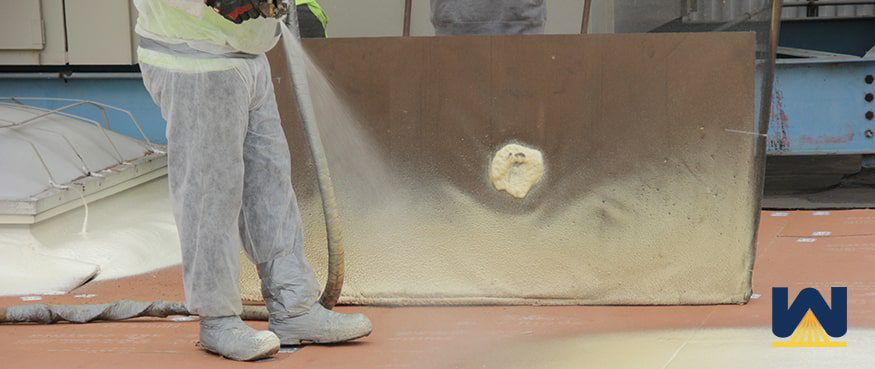So, you’re wondering if spray foam can stop a roof from leaking?
The answer is yes.
But you probably have other questions, such as:
- What is spray foam roofing?
- Do you install spray foam over the area that’s leaking, and that’s it?
- Do you need to install spray foam over an entire roof, or can you target one area?
- How long will spray foam stop a leak?
- How much will it cost to stop a leak with spray foam?
- Explain an example situation where spray foam stopped a roof leak.
- How does the process get started?
We will answer all of these questions below.
What is spray foam roofing?
Spray Foam Roofing is a material that’s sprayed as a liquid and expands into a foam, creating a solid monolithic layer of fully adhered insulation across an existing roof.
The usual application of spray foam is to repair and rejuvenate an existing roof by removing the saturated areas (if any), replacing them with like materials, and then spraying foam over top of the entire roof.

Do you install spray foam over the area that’s leaking, and that’s it?
For spray foam to cure correctly and perform at its maximum, spray foam needs to be applied to a dry, clean, and sound roof.
Dry means that the wet insulation will need to be removed and replaced with similar material.
For example, if you have a TPO roof with polyiso underneath, the wet polyiso will be removed and replaced with new polyiso. New TPO would then replace the old TPO.
If you don’t remove wet insulation, water will freeze and contract in the winter, which can cause cracks. This isn’t just with spray foam; freezing and cracking can happen with any roofing system. The cracking opens the roof membrane, which allows for more water to enter the roof system in the future.
If you have water in your insulation during the Summer, the insulation will hold that water (it will not evaporate), which can begin to rot out your wood or metal deck.
Spray foam needs to be applied to a clean roof. This is usually done with power washing, high-pressure air, or even with a coverboard over an existing roof system.
Spray foam also needs to be applied to a sound roof, meaning the existing roof needs to fully adhere to the insulation below.
In most cases, a cover board will be installed over your existing roof to give spray foam a solid structure to bond with.
Once the existing roof is dry, clean, and sound, spray foam can be applied.
Does spray foam need to be installed over the entire roof? Or can you target one area?
Spray foam is applied as a liquid and can be applied in any thickness based on your situation. Therefore, it can be installed to target just one area.
Many property owners choose this option because it costs less than replacing the entire roof.
However, spot repairs sometimes require water stops to ensure no water migrates into the spot repair from surrounding roof sections. Spot repairs cost more per square foot than spray foam over an entire roofing surface. This is because it takes time to get to the job site, time to set up, etc.
When applied to an entire roof, spray foam can cost between $5 and $10 per square foot. Spot repairs could cost more per square foot.
How long will the spray foam stop the leak?
Spray foam will stop a roof leak for as long as the building exists. This is because spray foam is a renewable roofing system.
If you didn’t know, spray foam would degrade when exposed to UV rays. To combat this, a silicone coating is applied over spray foam.
- For a 10-year warranty, 20 mils of coating will be applied over the foam.
- For a 15-year warranty, 25 mils of coating will be applied over the foam.
- For a 20-year warranty, 30 mils of coating will be applied over the foam.
Say you get a 10-year warranty. After 10 years, the coating may have worn down from 20 mils to 7-8 mils. The coating wears away naturally due to foot traffic and weather.
After 10 years, a contractor can renew the warranty by cleaning the area and installing the coating at its original thickness.
For the example above, after 10 years, the coating that was 7-8 mils thick will be brought back to 20 mils. Then a new 10-year warranty can be granted.
The process goes on and on and on.
There are plenty of roofs that we’ve recoated 3-4 times that have lasted 30+ years. They still have the original spray foam that was installed 30+ years ago!

How much will it cost to stop a leak with spray foam?
The cost to fix a roof with spray foam ranges from $4 per square foot to $10 per square foot.
What makes the cost go up or down depends on several factors, such as:
- How easy is it to access your roof?
- How big of an area will the spray foam be applied to?
- How much of the existing insulation will need to be removed and replaced?
- How long of a warranty would you like?
It all depends on the existing condition of the roof and the scope of work that needs to be done.
Explain an example situation where spray foam stopped a roof leak
Since 1979, hundreds and hundreds of roofs have been cured of leaking and are now watertight after a spray foam installation.
A great example is Master Bolt & Manufacturing in Elyria, OH.
Master Bolt is a 70,000 sq. ft. facility with leaking areas. Unable to afford a complete roof replacement, they considered making some roof repairs.
Being cost-conscious, pulling core samples throughout the entire roof was recommended. If the core sample was wet, then that area needed to be replaced and repaired. If the core sample is dry, the area can be left alone.
After cores were pulled, about 30,000 sq. ft. in four different sections were identified as being wet. Spray foam was applied to only those areas, while the rest of the roof was left alone.
This allowed Masterbolt to get their roof watertight and leak-free with the lowest amount of cost.

How does the process start?
The first step is to contact a commercial roofing contractor. They will have a discovery call with you to learn about what’s going on with your roof and what you would like done.
A roofing contractor will ask you some questions, such as:
- How old is your roof?
- What kind of roofing system is currently installed?
- Where is the leaking happening inside the building?
Then the roofing contractor will look up your address online, usually using Google Earth, to get an aerial view of your roof. Here they can tell where the penetrations are located, where drains are located, and many other details about your roof.
Once the discovery call is completed, you’ll set up a time to meet each other at your facility, where the roof inspection will take place.
Spray foam roofing and leaks
One of the best qualities of spray foam is that it’s fluid-applied, which closes any tiny holes and cracks that allow water into your roofing system, and eventually into your building.
Another positive is that spray foam can be applied to almost any existing substrate.
Now that you know spray foam is great against leaks, can be used as a repair option instead of paying for a complete roof tear-off, and can last as long as the building does, what other questions do you have?
For some building owners, they want to know more information about spray foam, such as:
- What advantages does spray foam have over other roofing systems?
- What common problems can spray foam roofs have?
- Does a spray foam roof need routine maintenance if I already have a warranty?


